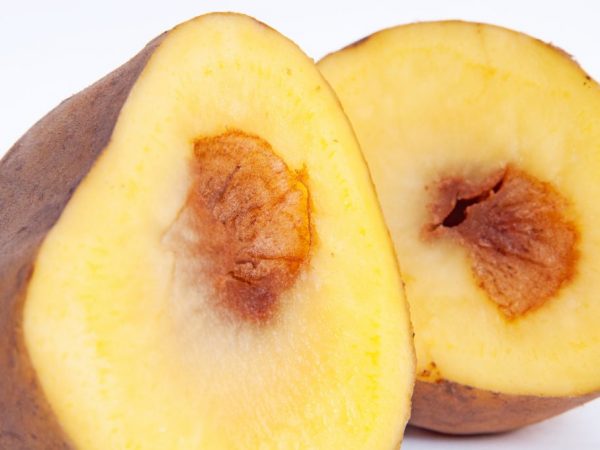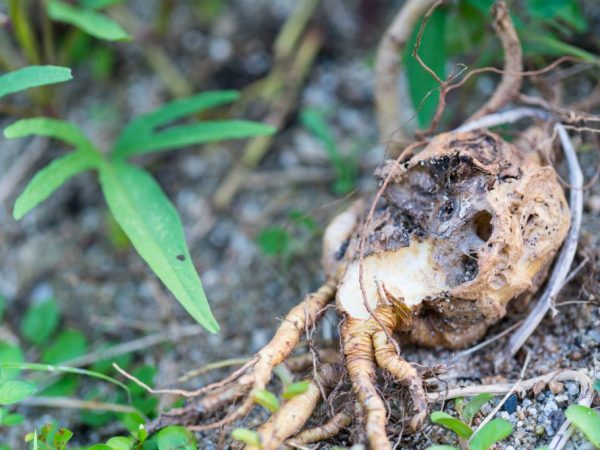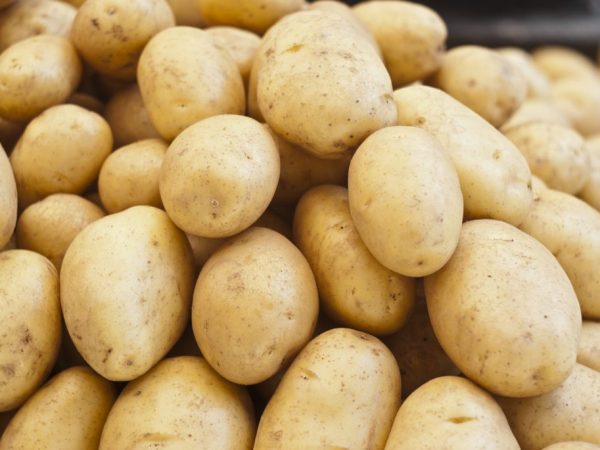Varieties of potato rot
A potato crop grown on your garden plot is not easy to preserve until spring, even if you take all measures to ensure long-term storage. For a number of reasons why stored vegetables begin to deteriorate, potato rot takes the first place.

Varieties of potato rot
Dry rot
The most common fungal disease of vegetable crops in areas in the south and southeast, as well as in the Russian Far East, is fusarium dry rot of potatoes. The danger of dry rot is that it can damage up to 40% of the entire potato crop. The second name of this fungal disease is fusarium brown potato rot.
The causative agent of dry fusarium disease of vegetables, which causes rotting of root crops, is a fungus that damages root crops and the root system of a plant, spreading through contaminated soil through vegetation residues and with infected potato tubers.
Signs
The primary signs of potato brown bacterial rot can be found at the flowering stage of the plant:
- the upper tier of the leaves of the potato bush begins to brighten, and subsequently withers,
- the lower tier of foliage becomes brown, in conditions of high humidity it can acquire a bloom with a pink or orange tint,
- vascular rings are observed in the section of the stem,
- tubers affected by dry Fusarium disease become dull, with a gray and brown tint, slightly depressed inward spots-spots, under which the potato pulp dries up, and the rind on top wrinkles.
The result of potato infection with dry Fusarium disease is complete drying of the plant: diseased tubers do not germinate well in the form of thin filamentous sprouts.
Wet rot
The causative agents of wet bacterial potato rot are saprophytic bacteria that infect root crops weakened by pests and other diseases.
The disease manifests itself exclusively during the storage period of the crop, when temperature conditions are exceeded and ventilation conditions are not observed.
A contributing factor for the development of the disease on potato tubers is the cultivation of a vegetable crop on waterlogged soil.
Signs
The main symptoms of damage to potato tubers are:
- decomposition of the tissues of the affected potato tubers and their subsequent growth into a mucous mass,
- specific putrid pungent odor from infected tubers.
When overwintered infected potatoes are planted, wet rotting can be expected during growth in the initial stages after planting. Cold soil is a provoking factor. The presence of rotted planting material becomes a source of infection for weakened tubers (damaged and frozen), and then spreads to healthy ones.
Ring rot

The disease is caused by bacteria
The defeat of potato tubers with ring rot occurs at the stage of root crop formation, in the process of damage to vegetables with mechanical methods of harvesting and with direct contact of the harvested potato tubers with the infected tops. Ring rot is triggered by an aerobic bacterium.
Signs
Pathogens begin to fill the vascular rings of vegetable tubers at the end of the winter period and the beginning of spring, and this becomes the cause of decay, the signs of which include:
- overgrowth of a rotting potato tuber into a white viscous mass,
- unpleasant smell from vegetables,
- voids inside the potato pulp.
Until the time of cutting the tubers, it is possible to guess about the defeat of the plant by the wilting of individual stems in the common bush:
- brown spots appear at the ends of the leaves,
- in some cases, the foliage becomes white due to a lack of chlorophyll in it,
- the foliage of the upper tier turns yellow and curls,
- the surface of the leaf plate becomes speckled,
- the lower layer of leaves withers and becomes shallow, the edges of the leaves curl upward.
Potato tubers that are weakly affected by ring rot are almost indistinguishable in appearance from healthy root crops, however, in the transverse size, you can see yellow lines passing along the vascular ring, the tissues are softened.
Blackleg
Blackleg develops under the influence of microbes that settle on weeds and then spread to vegetable crops. In this case, the activity of microbes remains at a temperature of 2 ° C to 32 ° C.
Signs
It is impossible to visually determine the presence of signs of damage to potato root crops in the early stages.
The black leg, according to the description, shows symptoms when creating favorable conditions for it in the form of increased dampness or excessive dryness. Moreover, among the most common signs of the presence of microbes are:
- blackening of the bottom of the potato bush,
- yellowing of leaves,
- general wilting of the plant,
- rotting tubers with darkened skin and cracks,
- liquid with a characteristic smelly odor.
As a result, in the root part, the black leg begins the process of softening the sprouts, the potato tubers become covered with black spots and begin to rot. Infected bushes can be easily pulled out of the soil layer. From the sections of the stems, mucous discharge is visible.
Rot control measures

It is important to store vegetables correctly
Measures to combat various types of potato rot are in treatment and preventive methods.
To prevent the activation of putrefactive fungi, it is of no small importance to comply with the general rules for storing vegetables in the basement or at home on the balcony. The creation of favorable conditions allows you to stop their activation, inhibiting development at the resting stage.
General prevention
The main preventive measures involve a number of simple, timely measures:
- balance of fertilizers when growing potatoes, allowing the development of plant resistance to diseases, avoiding an excess of nitrogen components and the mandatory inclusion of potassium,
- using healthy tubers for planting purchased from trusted sellers,
- planting a vegetable crop in unheavy soil, avoiding lowlands, where there is an excess of moisture,
- avoiding mechanical methods of harvesting, leading to frequent damage to tubers, rejection of damaged potatoes when transferring to storage,
- planting green manures that act as organic fertilizers,
- compliance with the rules of crop rotation and storage of vegetables.
Prevention by type of pathogen
The control measures taken for therapeutic prevention depend on the type of pathogen.
Against brown rot
There are no drugs to combat dry (brown) rot. Planting material for protection against disease is pretreated with phytosporin (50 g per 100 kg), bactophyte (up to 0.5 kg per 100 kg).Before laying potatoes for storage, vegetables are often treated with 0.2 liters of "Maxi KS", provided for 1 ton.
Against wet rot
Bacterial rot stops developing if you create an optimal storage regime for vegetables - from 1 ° C to -2 ° C - and ensure good ventilation. In such unfavorable conditions for pathogens, bacteria remain inactive. During storage, rotten roots are removed along with the neighboring ones.
As a treatment, potatoes are recommended to be treated with dry ash or phosphate rock (about 10 kg per ton of potatoes).
Against ring rot
In addition to the basic agrotechnical methods for the preliminary treatment of plants in the fight against pathogens, gardeners use fungicidal preparations, which they prefer to fight against diseases, treating the tubers before planting and before laying them for storage.
Against the black leg
It is possible to get rid of the microbe that causes the disease by treating the tubers with insecticidal or fungicidal substances such as TMTD. It is recommended to take such measures before boarding.


